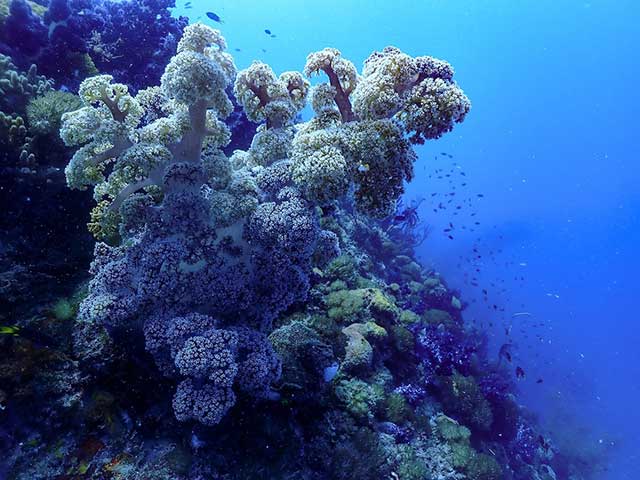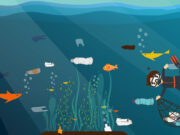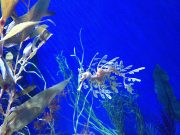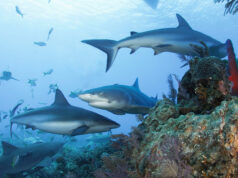When it comes to idyllic destinations with fantastic diving, it doesn’t get much better than Fiji. Made up of 330 islands, Fiji is a diver’s paradise and is known by many as the Soft Coral Capital of the World. As well as having jaw-dropping soft corals, Fiji hosts diverse underwater landscapes and a staggering array of marine life, from whales, mantas and bull sharks to prized critters. With easy-going reef dives and fast-paced dives for experienced divers only, Fiji has something for everyone. Read on for our top places to go diving in Fiji.

7 Great Places to Go Diving in Fiji
1. Viti Levu
Viti Levu is the largest of all the Fijian islands and is an idyllic getaway destination with crystal-clear waters and pristine beaches. Covered in green mountainsides and home to Fiji’s capital, Suva, there is plenty to do at this vibrant island.
Beqa Lagoon’s famous bull shark dive attracts divers from around the world to Viti Levu every year. This incredible multi-level dive is an unmissable Fiji diving highlight and a must for shark fans. As well as numerous bull sharks, you can spot tiger sharks, grey reef sharks, whitetip and blacktip reef sharks during this special shark dive.
Sitting at the southwest corner of Viti Levu, the Coral Coast has a fringing coral reef just offshore that provides perfect diving for beginner and experienced divers. There are great wall dives there, plus shallow reefs, caverns, swim-throughs and large overhangs busy with vibrant marine life. Turtles and dolphins are commonly seen there.

2. Bligh Water and the Koro Sea.
Lying between the two main islands of Fiji (Viti Levu and Vanua Levu) and washed by strong currents, Bligh Water and the Koro Sea host some of Fiji’s best diving.
The Namena Marine Reserve stretches across 70 square kilometers and has incredible marine biodiversity. Encompassing both Namena Island and a horseshoe-shaped barrier reef, the area has been a no-fishing zone since 1997. As a result, the dive sites are busy with vibrant tropical reef fish, critters, large pelagic fish and reef sharks.
If you’re looking for a thrilling drift dive, make sure you visit Nigali Passage. It has just a 3-hour window for diving, outside of which the currents scream past at over 4 knots. Dropping into the swift currents, you ride through the passage for around 20 meters. The steep walls on either side are covered in hard and soft corals and the passage itself hosts many barracuda and sharks.
The E-6 pinnacle is also a must for any dive trip to the area. Sitting in the narrowest section of Bligh Water, this seamount is constantly washed by nutrient-rich water and is a jaw-dropping marine ecosystem.
Typically for this area of Fiji, there are impressive reefs and abundant pelagics wherever you dive. Make sure you leave time to dive the lesser-known islands such as Koro Island and Wakaya Island.
3. Gau Island.
Gau Island, also known as the Amazon of the Seas, hosts an impressive array of marine life and offers a mix of fringing reef, barrier reef, and lagoon diving. There is a variety of dive sites to explore for all experience levels.
Jim’s Alley is ideal for novice divers who want to experience the wealth of life in Fiji’s waters. This shallow coral garden has numerous hard and soft corals, sea fans, whip fans, and anemones. For Fiji’s best hard coral gardens, make sure you also go diving at Koro Gardens.

Shark Fin Point is a great drift dive with plenty of pelagic action, including hundreds of barracuda, eagle rays, whitetip reef sharks, grey reef sharks and numerous vibrant corals.
4. Taveuni
Known as the Garden Island for its lush plant life, Taveuni is the ideal destination to combine scuba diving with other adventure activities. There are tropical rainforests with abundant wildlife, excellent jungle hikes, waterfalls, and world-class surfing on offer.

Dive in and you can explore Fiji’s most sought-after dive destination, the Somosomo Strait. This passage runs between Vanua Levu and Taveuni Island and is washed by strong currents, creating some of the most colorful wall and drift dives imaginable.
When the current runs, the walls come to life with white, purple, pink and orange soft corals. The aptly-named Great White Wall dive site has so many white corals that it looks like a wall of snow and the Purple Wall is equally as remarkable.
5. Mamanuca Islands.
The Mamanuca Islands, as an archipelago of around 20 small islands, are a remote island getaway with excellent diving and snorkeling. As well as beautiful palm-fringed beaches, there are colorful coral reefs and lagoons to explore. The islands also host action-packed pelagic, drift, night and wreck dives.
Sea turtles are commonly seen around Fiji’s islands, and you can spot nesting hawksbill and green sea turtles at the Mamanuca Islands from October to April each year. The islands are also a manta and shark hotspot, with bull sharks, nurse, lemon and tiger sharks.

6. Kadavu
Tucked away in the southernmost area of Fiji, Kadavu is well off the beaten path and is the place to go to immerse in the Fijian culture. There are a few eco-friendly resorts at Kadavu and very little mainstream tourism.
Kadavu is known for the Great Astrolabe Reef, the fourth largest barrier reef in the world. Sitting just off the southern shore, this spectacular reef hosts tuna, marlin, sharks, and an array of reef fish, with excellent hard and soft coral cover.
The diverse underwater landscapes of Kadavu include steep drop-offs, passages, pinnacles and manta cleaning stations.
7. Yasawa Islands
The Yasawa Islands are the driest and warmest part of Fiji, with plenty of sunshine hours to keep you warm between your dives. With so many excellent dives, you could easily spend a long vacation there.
Barefoot Manta Island sits to the south of the Yasawa Islands and is known for hosting plenty of mantas from May to October each year. If you want to swim with mantas, here and Naviti Island will meet your needs.
As well as mantas, Naviti Island also has a unique cave dive at Babylon Caves, with a complex cave system that requires navigation and ends at a reef-capped wall. There are also spectacular caves and canyons at Sawa-i-Lau Island.

For steep walls and pelagic action, visit Tavewa Island. Tavewa’s dive sites are busy with barracuda, mackerel, trevally, and other pelagics. It is also a great destination to find prized macro life and unusual corals, including black corals.
Shark snorkeling near Kuata and the Waya Islands is one of the most sought-after activities for non-divers visiting these beautiful islands.

What experience do you need to go diving in Fiji?
Fiji has a range of dive sites for every experience level. Calm sheltered waters and plenty of marine life close to shore make it a perfect place to get your Open Water Diver certification.
If you want to explore Fiji’s most spectacular dive sites, such as those at Somosomo Strait, complete a Drift Diving and a Deep Diving specialty before you go.

When is the best time to go diving in Fiji?
Fiji has a year-round dive season, though winter (April to October) is the most popular time for diving.
Highlights of diving in Fiji during winter:
- Deep blue waters and spectacular visibility.
- Great season for big fish encounters.
- Manta ray season from May to October.
- Humpback whales arrive in Fiji from June onwards.
Summer (November to April) brings warmer waters and lower visibility due to algae and plankton blooms.
Highlights of diving in Fiji during summer:
- Great season for macro diving.
- The reefs come to life with new critters and fish.
- Coral spawning occurs around November.
- Sea turtle nesting season occurs from April to October.
What marine life can you see when diving in Fiji?
Fiji hosts an abundance of marine life, with over 1200 different fish species, plus numerous critters and crustaceans. Fiji is famous for its soft corals, which have created some of the most vibrant reefs in the world, and there are also excellent hard coral gardens.
As well as biodiverse reefs, Fiji hosts numerous pelagic fish, plus sea turtles, eagle rays, reef sharks, bull and tiger sharks, dolphins and whales.
Kathryn Curzon, a shark conservationist and dive travel writer for SSI (Scuba Schools International), wrote this article.
Main photo credit: Thomas Borb/Unsplash

















